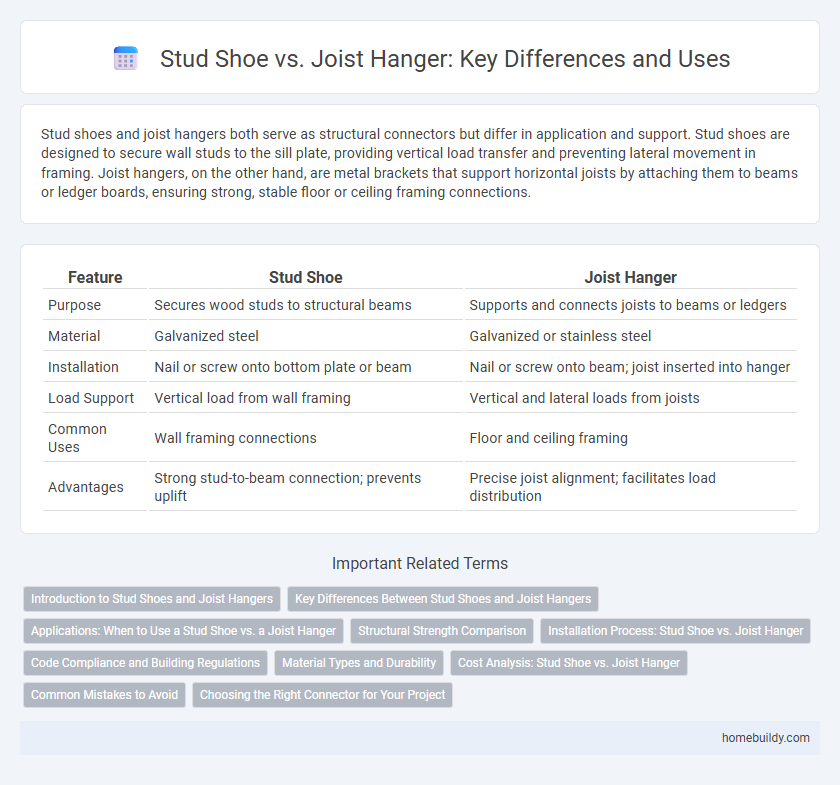Stud shoes and joist hangers both serve as structural connectors but differ in application and support. Stud shoes are designed to secure wall studs to the sill plate, providing vertical load transfer and preventing lateral movement in framing. Joist hangers, on the other hand, are metal brackets that support horizontal joists by attaching them to beams or ledger boards, ensuring strong, stable floor or ceiling framing connections.
Table of Comparison
| Feature | Stud Shoe | Joist Hanger |
|---|---|---|
| Purpose | Secures wood studs to structural beams | Supports and connects joists to beams or ledgers |
| Material | Galvanized steel | Galvanized or stainless steel |
| Installation | Nail or screw onto bottom plate or beam | Nail or screw onto beam; joist inserted into hanger |
| Load Support | Vertical load from wall framing | Vertical and lateral loads from joists |
| Common Uses | Wall framing connections | Floor and ceiling framing |
| Advantages | Strong stud-to-beam connection; prevents uplift | Precise joist alignment; facilitates load distribution |
Introduction to Stud Shoes and Joist Hangers
Stud shoes and joist hangers are essential metal connectors used in framing to enhance structural stability and load distribution. Stud shoes secure wall studs to the base plate, preventing lateral movement and splitting, while joist hangers support floor or ceiling joists by providing a robust anchor point to beams or ledgers. Both components are typically made from galvanized steel to resist corrosion and ensure long-lasting performance in wooden frameworks.
Key Differences Between Stud Shoes and Joist Hangers
Stud shoes primarily provide lateral support and anchorage at the base of wall studs, preventing twisting and improving load distribution, while joist hangers are designed to support horizontal framing members, such as floor or ceiling joists, by securely attaching them to beams or ledger boards. The key difference lies in their functional application: stud shoes reinforce vertical load-bearing studs against lateral forces, whereas joist hangers facilitate the connection of joists to structural elements, enabling efficient load transfer across horizontal spans. Material composition and installation methods also vary, with stud shoes typically being thicker and more rigid to resist shear forces, and joist hangers featuring open-sided designs to accommodate joist placement and nail fastening.
Applications: When to Use a Stud Shoe vs. a Joist Hanger
Stud shoes are ideal for securing studs to concrete or masonry surfaces, providing a robust anchor point in wall framing applications where direct attachment to the foundation is required. Joist hangers excel in supporting horizontal joists by attaching them to beams or ledger boards, ensuring load distribution and structural stability in floor and ceiling constructions. Choose stud shoes for vertical load transfer at base plates, and joist hangers when connecting and supporting horizontal framing members in wood-framed structures.
Structural Strength Comparison
Stud shoes provide superior lateral support by securely anchoring studs to concrete or steel surfaces, distributing loads evenly and reducing shear stress. Joist hangers primarily offer vertical support for floor joists, transferring weight to beams but exhibiting less resistance to lateral forces compared to stud shoes. Their structural strength varies according to material gauge and installation quality, with stud shoes generally excelling in scenarios requiring enhanced stability against multidirectional forces.
Installation Process: Stud Shoe vs. Joist Hanger
Stud shoe installation involves securing the bracket directly onto the wall stud with nails or screws, providing lateral support for ledger boards or beams. Joist hanger installation requires precise placement beneath joists, fastening with manufacturer-approved nails to ensure load transfer and prevent sagging. Both methods demand proper alignment and fastener selection to maintain structural integrity and meet building codes.
Code Compliance and Building Regulations
Stud shoes and joist hangers both meet code compliance standards, but stud shoes must comply specifically with the International Residential Code (IRC) for lateral load resistance in wall framing. Joist hangers are governed by local building codes such as the International Building Code (IBC) and must be installed following manufacturer specifications to ensure structural integrity. Building regulations require both components to be tested and certified for load capacity, corrosion resistance, and proper fastening methods to guarantee safe, code-compliant construction.
Material Types and Durability
Stud shoes are typically made from galvanized steel, providing excellent resistance to corrosion and ensuring long-lasting durability in various environmental conditions. Joist hangers, also commonly constructed from galvanized steel, offer strong support but may differ in thickness and treatment depending on load requirements. Both materials prioritize strength and longevity, but stud shoes often incorporate heavier gauge steel for enhanced stability in vertical load-bearing applications.
Cost Analysis: Stud Shoe vs. Joist Hanger
Stud shoes typically offer a cost-effective solution for connecting joists to studs, often priced lower than joist hangers due to simpler design and easier installation. Joist hangers, while more expensive upfront, provide enhanced load distribution and structural stability, potentially reducing long-term repair costs. Evaluating project budgets and structural requirements helps determine whether the initial savings of stud shoes or the durability benefits of joist hangers deliver better overall value.
Common Mistakes to Avoid
When installing stud shoes versus joist hangers, a common mistake is misidentifying their applications, as stud shoes are designed for securing studs at foundations while joist hangers support horizontal floor joists. Using a stud shoe in place of a joist hanger can compromise structural integrity due to improper load distribution. Ensuring the correct hardware selection prevents framing failures and meets building code requirements for safety and durability.
Choosing the Right Connector for Your Project
Stud shoes provide a strong, stable base for securing vertical wood studs to concrete or masonry surfaces, ensuring proper load transfer and alignment. Joist hangers are designed to support horizontal beams by attaching them to perpendicular framing members, distributing loads evenly across the structure. Selecting the right connector depends on your project's framing requirements, with stud shoes ideal for vertical support and joist hangers suited for horizontal beam connections.
Stud shoe vs joist hanger Infographic

 homebuildy.com
homebuildy.com